Part of a series of articles titled Alaska Park Science - Volume 19, Issue 1 - Below the Surface: Fish and Our Changing Underwater World.
Article
Elodea: Alaska’s First Invasive Aquatic Plant Continues to March Across the State
Tobias Schwoerer and Justin Fulkerson, University of Alaska Anchorage
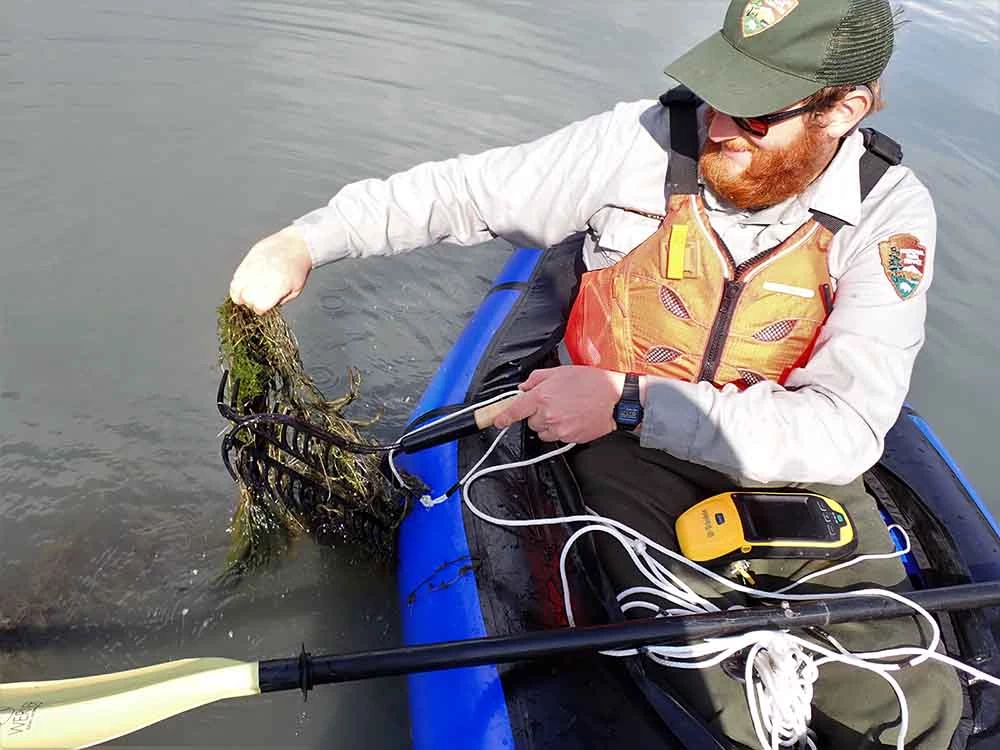
NPS/S. SAMPSON
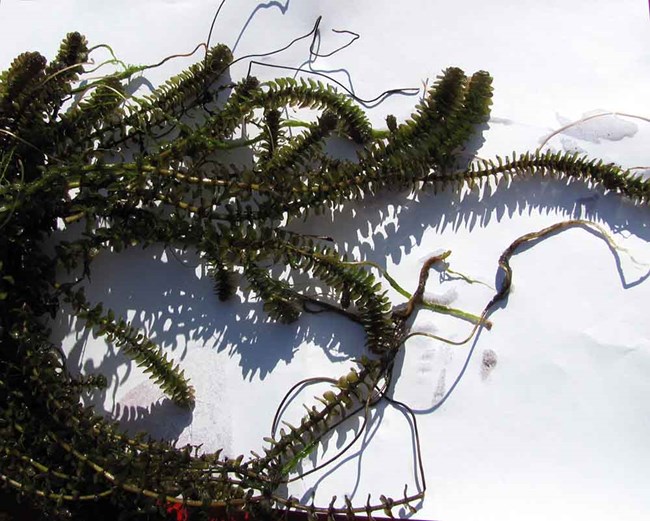
Elodea spp. (waterweed) is a hardy aquatic plant that grows in cold, clear, slow-moving water (Figure 1). It is considered a circumpolar invasive plant; its native range extends from Florida to southern British Columbia. Elodea was first found growing in Eyak Lake, a large lake in Cordova, Alaska, in 1982. In 2010, it was subsequently found in the Chena River by US Forest Service employees trying to familiarize themselves with invasive plants. Their discovery spurred a large state-wide campaign to raise awareness about invasive aquatic plants in Alaska and to treat the known infestation. The long lag time between the two discoveries was due to a lack of research on native aquatic plant distributions and our limited understanding of aquatic invasive species.
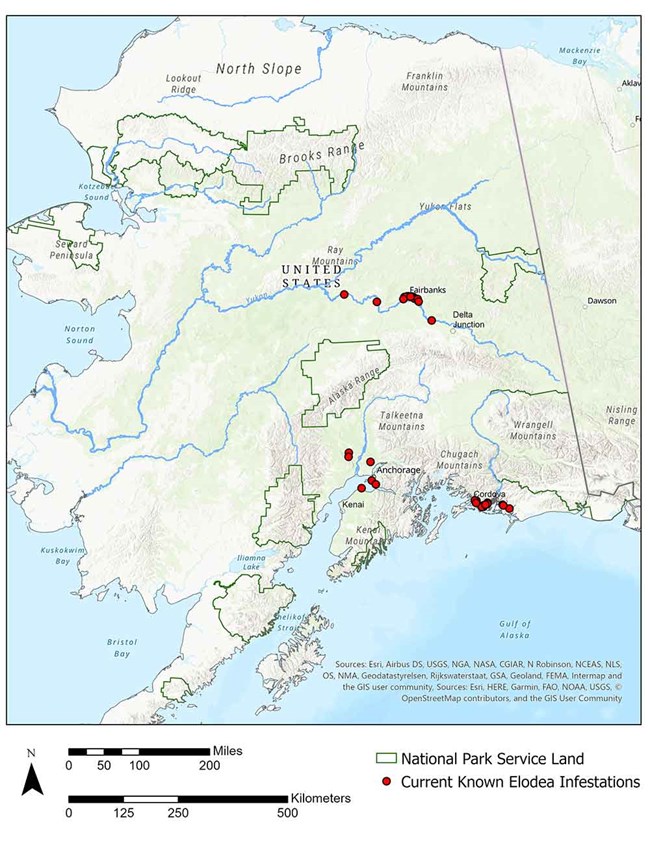
Over the past eight years, 29 invasive aquatic plant infestations have been identified across Alaska, including lakes within Anchorage, Fairbanks, Cordova, Nenana, Kenai, and the Matanuska-Susitna Borough as well as riverine systems near Fairbanks and Cordova (Figure 2). In Alaska, introductions of Elodea probably occurred when people dumped their aquariums into nearby lakes and streams, possibly believing the aquarium plants and animals wouldn’t survive. Unfortunately, they often did. New infestations are being found each year, further and further from urban populations. Land managers have applied herbicides to successfully eradicate Elodea from eight lakes and are working on the remaining water bodies.
Elodea is the first known freshwater invasive plant to be found in Alaska and with it come significant environmental concerns. Once a bed of Elodea becomes established, it grows rapidly, blocking light and taking up nutrients other plants might use to grow and essentially creating a monoculture (Rorslett et al. 1986, Spicer and Catling 1988). Elodea often grows so profusely that it slows stream flow and mixing rates (Spicer and Catling 1988, Gollasch 2006), allowing sediment and fine particles to settle out of the water and cover the gravel in areas where salmon, whitefish, and grayling spawn. Its explosive growth is typically followed by a sudden die back, which then decomposes in the water. The organisms decomposing all the dead vegetation rapidly consume the oxygen in the water, making it difficult for fish and other aquatic organisms to survive (Simberloff and Gibbons 2004, Buscemi 1958, Pokorný et al. 1984).
Elodea spreads easily; it only takes a small piece of stem, 2 inches (5 cm) long, for the plant to become established in a new location. It can withstand extended periods of drying as well as freezing (Nichols and Shaw 1986). Because it’s so hardy, it can easily be dispersed by floatplanes and outboard motors that travel long distances. It can live in lakes as well as streams and even grows during winter, under the ice, when native plants die. Anglers have reported pulling large, live, green strands of Elodea from their ice-fishing holes. During the spring, tiny fragments are carried downstream with the ice and spread to other lakes and streams many miles away.
Not only does Elodea cause environmental damage, but it can also impede watercraft navigability and create hazardous conditions for floatplane operators (Schwoerer et al. 2019a) and other recreationists. According to a recent survey, Alaska floatplane pilots said they would reduce the frequency of flights, or even stop visiting lakes and streams completely, if the landing areas became infested with Elodea. A recent economic analysis of personal floatplane flights estimates that an Elodea infestation could reduce the recreational value of a trip by $185 per flight (Schwoerer 2019a). Given the more than 3,000 floatplane-certified pilots in the state, Elodea could cause a significant loss in recreation opportunities. In other states it has reduced property values (Zhang and Boyle 2010) and visitor use (Josefsson and Andersson 2001). Large infestations reduce the scenic quality of natural settings. Once established, Elodea infestations can be costly to eradicate. For example, the United Kingdom spends 40 million dollars annually on Elodea eradication (Simberloff and Gibbons 2004).
In addition to its impacts on recreation, Elodea could also affect Alaska’s commercial salmon fisheries. Economic research suggests that if Elodea is not eradicated and spreads into the state’s most productive salmon watersheds, commercial sockeye salmon fisheries are likely to become less productive, resulting in decreased harvest. An economic study that simulated the potential effect of Elodea on salmon productivity with consequences for wild salmon markets, estimated that Elodea could potentially reduce revenue to commercial harvesters by an average of $97 million annually. This loss is equivalent to 16% of the statewide average wholesale value for sockeye salmon over the past ten years (Schwoerer et al. 2019b).
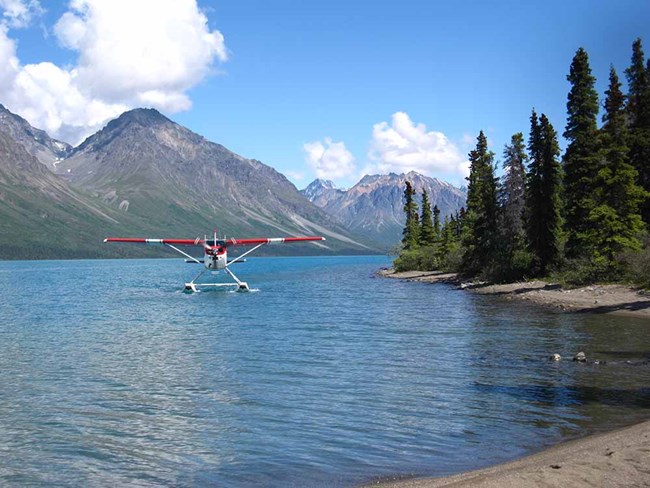
NPS/D. YOUNG
A Landscape at Risk
There are over three million lakes and 12,000 rivers in Alaska, offering prime opportunities for Elodea to thrive. Alaska’s national parks encompass a substantial portion of this habitat and include some of Alaska’s most iconic lakes and rivers (Figure 3). This, combined with high visitor use, puts National Park Service (NPS) lands at high risk of becoming infested.
Nearly half of the infestations in Alaska are in floatplane-accessible water bodies. The infestation of Alexander Lake, 60 miles (96.5 km) south of Denali National Park and Preserve, originated from Sand Lake, Anchorage, and the infestations of Bering and Martin lakes, 35 miles (56.3 km) south of Wrangell-St. Elias National Park and Preserve, originated from Eyak Lake, Cordova. The most notable infestation was in Lake Hood, the world’s busiest floatplane base, where more than 69,000 floatplanes take off or land each year. Survey data show that flights from Lake Hood terminate in hundreds of lakes and rivers throughout the state, many of which are in national parks in southwest Alaska (Figure 4; Schwoerer 2017). In total, more than 9,000 flights terminate in NPS water bodies each year, most of which originate in Lake Hood and terminate in Katmai, Lake Clark, and Wrangell-St. Elias national parks and preserves. Fortunately, the State of Alaska successfully eradicated Elodea from Lake Hood in 2015 and it has remained clear of infestation since.
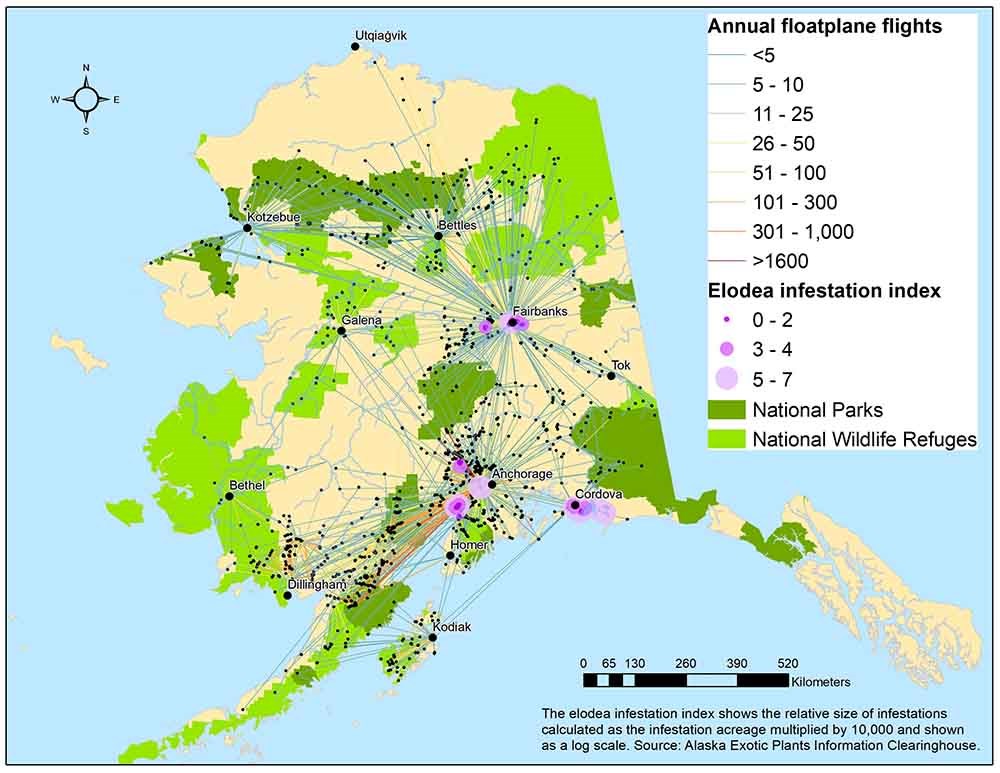
Pink dots indicate the number of infested sites in the area, as reported in the Alaska Exotic Plants Information Clearinghouse.
Outboard motor boats can also spread Elodea when it becomes entangled on a prop or anchor and is transported to new locations hundreds of miles away. Many of Alaska’s national parks and wildlife refuges are accessed from public boat launches with existing infestations of Elodea. Two such infestations remain uncontrolled; one of these is located near a public boat launch in Manley Hot Springs, a small community along the Tanana River, and the other is located in the Alaganik Slough in the Copper River Delta. A 2018 statewide survey (Schwoerer et al. 2020a) of Alaska’s registered boat owners showed that boaters routinely access Denali and Wrangell-St. Elias national parks and preserves via rivers connected to these boat launches.
Over the past two years, NPS scientists have surveyed some of the most frequently visited sites in southern Alaska parklands, including iconic lakes such as Lake Clark and Katmai Lake. Although these surveys have found no Elodea, scientists are concerned the plant may be present but is not being detected. The surveys cover only a fraction of the lakes and streams that could be infested and many of the lakes are large, with complex shorelines that are expensive and time consuming to survey; infestations could easily be overlooked. To help address these challenges, NPS is working to develop survey techniques that will increase the chances of finding an infestation in its early stages so it can be treated quickly. Eradication of invasive species has the greatest chance of success early on before they become established.
One technique for early detection that shows great promise involves the use of environmental DNA (eDNA), which is DNA that organisms constantly shed into their environment. It can be easily collected by filtration of water samples taken from streams or lakes and can detect the presence of aquatic species without requiring their physical capture or observation. NPS scientists are collaborating with scientists from the US Geological Survey and US Fish and Wildlife Service to develop these techniques for determining the presence of Elodea (Simmons et al. this volume). This tool will allow scientists to detect not only Elodea, but also other invasive aquatic species that may be present. Using these approaches, eDNA samples from 58 lakes in Lake Clark, Katmai, and Wrangell-St. Elias national parks and preserves and Kenai Fjords National Park have been tested so far. No Elodea was detected at any of these locations. Elodea DNA was successfully detected in samples taken from water bodies with known infestations, giving the scientists confidence that the technique works. The success of these eDNA assays suggests that Elodea might be reliably detected even when plants are not physically observable. This would allow for rapid and inexpensive surveys to be conducted using water samples, potentially eliminating the need for exhaustive and costly surveys. However, this technology is still relatively new and more work remains to be done, particularly in terms of quantifying its sensitivity to the presence of Elodea in low densities. Nevertheless, early detection is the key to quickly and effectively eradicating Elodea infestation and eDNA may allow detection before the infestation becomes difficult and costly to treat (Carey et al. 2016).
On-the-ground surveys will still be required anytime a potential infestation is detected using indirect methods like eDNA. In addition to confirming the presence of Elodea, physical surveys provide information on infestation size and location, as well as data on the waterbody itself, information that is critical in determining what kind of treatment will be most effective.
Finding invasive plants in terrestrial settings is relatively straightforward and there are several standardized methods to conduct field surveys in a repeatable fashion, yielding data that can be compared to other surveys and studies. However, finding and documenting aquatic plants is more challenging due to poor visibility, limited accessibility, and a heterogeneous environment. These factors lower the probability of detecting Elodea and confidence that it is truly absent from the lake. For example, a field survey of a Kenai lake failed to detect Elodea, but was found to be common in a subsequent survey with a more careful approach. Currently there are no statistically rigorous methods for invasive aquatic plant surveys in Alaska and land managers want to be confident that they have the best available information.
NPS is working with the Alaska Center for Conservation Science at the University of Alaska Anchorage (UAA) to develop a standardized protocol that can help compensate for low detection rates. The UAA team has been testing a statistical survey method that is commonly used in wildlife studies and produces an unbiased estimate of species presence. To date, the UAA team has documented new Elodea occurrences in already infested lakes to help improve detection methods and identify preferential habitat. Early results are encouraging; using this method novice and expert observers are equally effective at detecting Elodea, allowing for flexibility of who can perform the survey. Early results also indicate that native aquatic vegetation is typically sparse or non-existent in cobble to boulder lake substrates and deeper waters, but Elodea can occupy these habitats, making it a truly weedy species.
The UAA team searched for Elodea in lakes of the Wrangell-St. Elias National Park and Preserve in 2018 and Gates of the Arctic National Park and Preserve in 2019; Elodea was not detected during these surveys. For 2020, the UAA team plans to search for Elodea in the Yukon-Charley Rivers National Preserve.
UAA’s Institute of Social and Economic Research is working with the NPS to develop both aviation and motorboat use models to help prioritize search efforts. Pilot surveys have identified 255 floatplane-accessible destinations within, and near, NPS lands (Schwoerer 2017). Most (two-thirds) of these locations are infrequently visited (<10 flights per year), less than a quarter receive between ten and 50 flights a year, and the remaining 26 lakes receive more than 50 flights a year. Sixteen of these are frequently visited and receive more than 100 flights a year. A probabilistic model of the observed flights shows the lakes and rivers with the highest probability of infestation are concentrated in southcentral and southwest Alaska. The model estimates, with high confidence (low variance), that sites within Denali, Lake Clark, Wrangell-St. Elias, and Katmai national parks and preserves are at greatest risk of infestation (Figure 5).
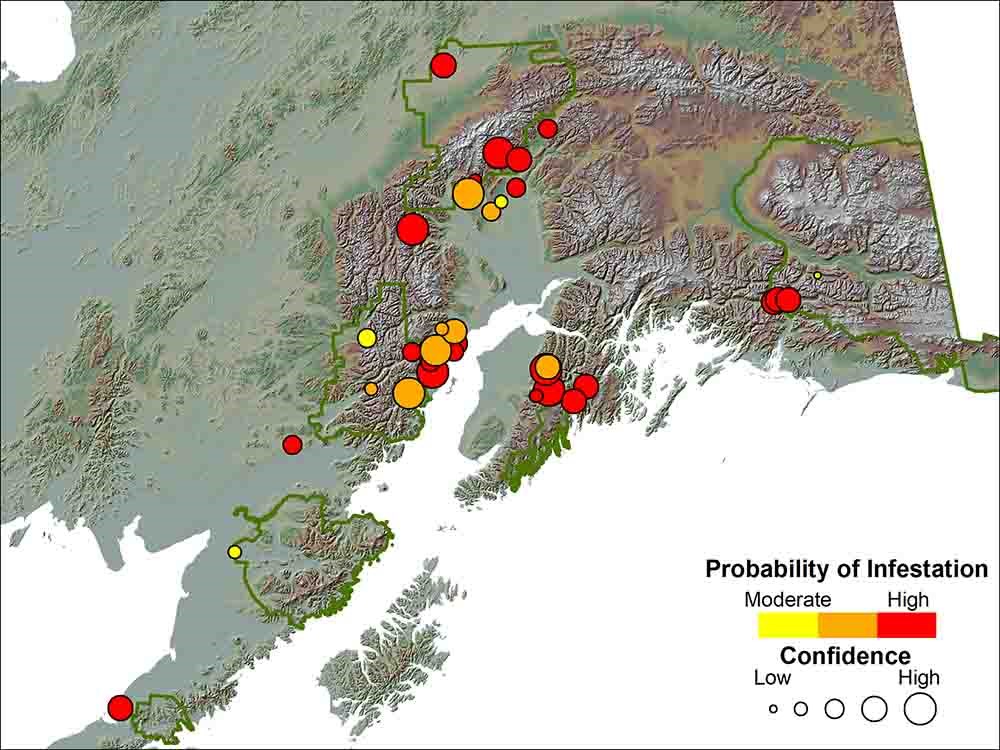
Sites with a large red dot are lakes with both the high confidence and probability an infestation will occur (Schwoerer et al. 2020b).
NPS Works to Prevent Future Infestations and Make Ready for a Possible Discovery
Invasive species management techniques vary considerably, but recent research suggests that the best strategy is to first eradicate known infestations and then to prevent its spread (Lodge et al. 2016). Keeping urban source locations, such as Lake Hood, clean of aquatic invasive species is paramount to keeping remote conservation lands free of infestation. Close monitoring of these potential source areas following treatment is the most effective way to maintain healthy urban waterways.
Prevention methods have proven to be highly effective in managing aquatic invasive species when applied in coordination with local, state, and other federal agencies. Since Elodea remains in Eyak Lake and other waterbodies accessed by motorboats and floatplanes, these source locations continue to threaten conservation lands, either directly through flights and motorboat transport, indirectly by passive flow of rivers and streams, or by expansion of existing infestations. Until these populations can be eradicated, Elodea poses a serious risk to lakes and streams in Alaska’s national parks. NPS staff have been collaborating with partners throughout the state to produce educational materials to prevent the spread of Elodea. Pilots have been a primary audience for outreach, as have all tour operators and concessionaires working in parks.
Treatment of Elodea infestations with herbicides and restoration of treated waterbodies is time consuming and costly. For example, treatment of an 11-mile (17.7 km) section of Chena Slough is expected to take four years and cost a million dollars. Native plant richness quickly rebounds after Elodea is eradicated (Sethi et al. 2017), demonstrating the positive effects herbicide application has on the native aquatic plant flora. If the NPS can prevent an infestation, it can avoid the high cost of treating and restoring its aquatic ecosystems.
Alaska’s parks are some of the state’s most treasured destinations and home to some of the state’s most vital salmon fisheries. A multitude of federal, state, and private partners are actively working to eradicate Elodea from Alaska by sharing ideas, information, and resources. Since invasive species do not recognize political or management boundaries, it is critical that NPS do its part in stewarding this land by protecting these resources from degradation. Preventing the spread of Elodea into parks is the most cost-effective and ecologically conservative means to do so.
References
Buscemi, P. A. 1958.
Littoral oxygen depletion produced by a cover of Elodea canadensis. Oikos 9: 239-245.
Carey, M. P. and S. A. Sethi, S. J. Larsen, and C. F. Rich. 2016.
A primer on potential impacts, management priorities, and future directions for Elodea spp. In high-latitude systems: learning from the Alaskan experience. Hydrobiologia 777: 1-19.
Gollasch, S. 2006.
Overview on introduced aquatic species in European navigational and adjacent waters. Helgoland Marine Research 60(2): 84-89.
Josefsson, M. and B. Andersson. 2001.
The environmental consequences of alien species in the Swedish lakes Malaren, Hjalmaren, Vanern, and Vattern. AMBIO: A Journal of the Human Environment 30(8): 514-521.
Lodge, D. M., P. W. Simonin, S. W. Burgiel, et al. 2016.
Risk analysis and bioeconomics of invasive species to inform policy and management. Annual Review of Environment and Resources 41: 453-488.
Nichols, S. A. and B. H. Shaw. 1986.
Ecological life histories of the three aquatic nuisance plants, Myriophyllum spicatum, Potamogeton crispus, and Elodea canadensis. Hydrobiologia 131(1): 3-21.
Pokorný, J., J. Květ, J. P. Ondok, Z. Toul, and I. Ostrý. 1984.
Production-ecological analysis of a plant community dominated by Elodea canadensis Michx. Aquatic Botany 19(3): 263-292.
Rorslett, B., D. Berge, and S. W. Johansen. 1986.
Lake enrichment by submersed macrophytes: A Norwegian whole-lake experience with Elodea canadensis. Aquatic Botany 26: 325-340.
Schwoerer, T. 2017.
Invasive Elodea threatens remote ecosystem services in Alaska: A spatially explicit bioeconomic risk analysis. University of Alaska Fairbanks. Available at: http://hdl.handle.net/11122/7639 (accessed April 17, 2020)
Schwoerer, T., J. M. Little, J. I. Schmidt, and K. W. Borash. 2019a.
Hitchhikers on floats to Arctic freshwater: Private aviation and recreation loss from aquatic invasion. AMBIO: A Journal of the Human Environment 49: 1364-1376.
Schwoerer, T., J. Little, and M. Adkison. 2019b.
Aquatic invasive species change ecosystem services from the world’s largest wild sockeye salmon fisheries in Alaska. Journal of Ocean and Coastal Economics 6(1): article 2.
Schwoerer, T., T. Davis, K. Borash, and A. Martin. 2020a.
Human dimensions of aquatic invasive species in Alaska: A participatory geographic pathway analysis. Manuscript in preparation.
Schwoerer, T., J. Schmidt, and R. Dial. 2020b.
Predicting invasive species dispersal at the arctic invasion front: A citizen science approach. Manuscript in preparation.
Sethi, S., M. P. Carey, J. M. Morton, E. Guerron-Orejuela, R. Decino, M. Willette, J. Boersma, J. Jablonski, and C. Anderson. 2017.
Rapid response for invasive waterweeds at the arctic invasion front: Assessment of collateral impacts from herbicide treatments. Biological Conservation 212: 300-309.
Simberloff, D. and L. Gibbons. 2004.
Now you see them, now you don’t—population crashes of established introduced species. Biological Invasions 6: 161-171.
Spicer, K. W. and P. M. Catling. 1988.
The biology of Canadian weeds: 88. Elodea canadensis Michx. Canadian Journal of Plant Science 68(4): 1035-1051.
Zhang, C. and K. J. Boyle. 2010.
The effect of an aquatic invasive species (Eurasian watermilfoil) on lakefront property values. Ecological Economics 70(2): 394-404.
Last updated: May 29, 2020
